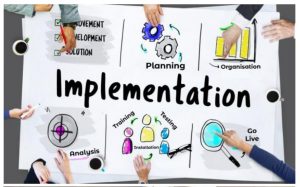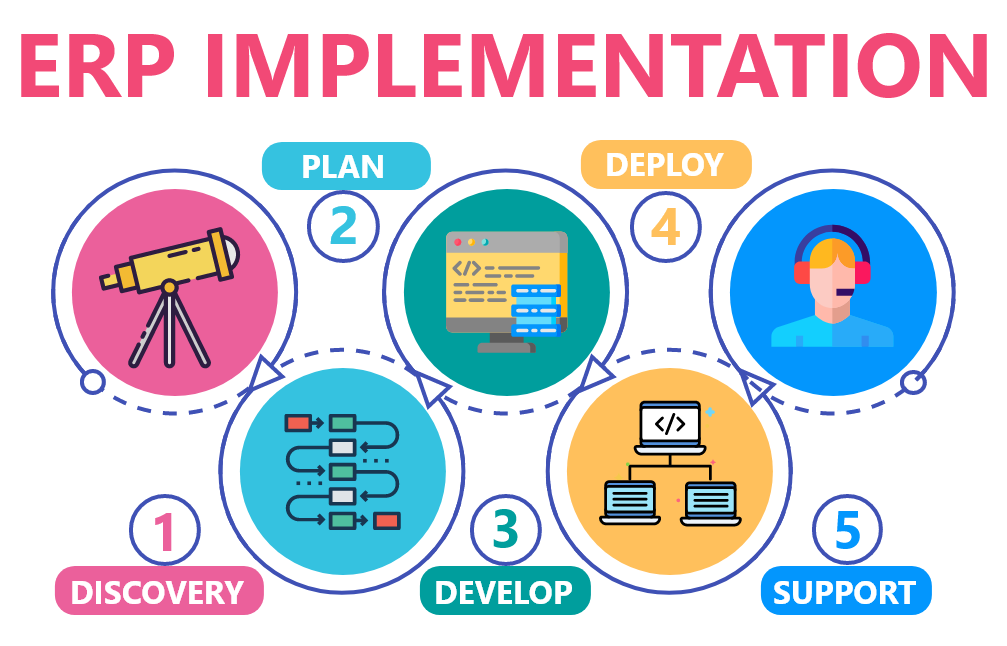Implementation of ERP – Businesses rely on an automated company management system to improve efficiency and productivity. Choosing the right ERP software can help to improve all of a company’s business activities.
This blog outlines the tactics for establishing the best ERP system in a business.

ERP Deployment Stages
To ensure a seamless deployment, ensure that the ERP system chosen for a company matches its needs. ERP implementation in a business is divided into six stages. These stages may vary and overlap, but firms generally follow them.
Exploring and Planning
The company organizes a project team to gather the firm’s requirements and difficulties that an ERP system should answer. The team is tasked with shortlisting vendors, issuing requests for proposals, selecting the proper ERP systems, managing the deployment, and ensuring that the ERP fits the firm’s needs.
Design
Flexibility is vital because managers and business process controllers must be willing to change how they do their jobs. The team assesses the current workflows and determines how to modify them using a new system. It analyses the Enterprise Resource Planning features required for the organization, the customizations required, and the data required.
Development
The integrated partner and team collaborate to build the software to meet business requirements and create training materials and papers for deployment and data migration.
Testing
Before moving ahead, evaluate the program, solve any faults, and make necessary corrections. All ways an employee utilizes the system should be reviewed to ensure error-free.
Deployment
After completing the configuration, data migration, and testing, provide proper training to staff on utilizing the system to make the company’s operations more efficient.
Support
The development team validates the user’s support and aids in the system’s upgrade and debugging. If you choose an on-premises ERP Software, you will require specialized IT resources for security, updating, upkeep, and debugging.

Leading ERP Implementation Approaches
Below are the various ERP implementation approaches, each with advantages and disadvantages.
1. Big Bang
The approach is often referred to as the “single-step method.” Users accept the new system at the same time in this case. To accomplish this, the new system must be configured and tested to ensure that it is error-free. In addition, sufficient training must be offered to all staff for the new system to be more efficient.
This method expedites the attainment of ERP benefits.
2. Phased Rollout
The implementation of an ERP is done in stages, which might take weeks or months, according to this plan. This method is less dangerous than the extensive bang method and permits employees to be trained. The disadvantage of this method is that it takes a long time to reap the rewards.
3. Parallel Adoption
A paradigm shift occurs when an organization implements a new ERP system alongside its previous system. This is typically a low-risk solution because you can revert to your legacy system if problems arise. However, simultaneous adoption is expensive because it requires more employees, time, and resources.
4. Hybrid
It entails all of the preceding stages. ERP is installed in a Hybrid manner based on the firm’s demands and using diverse methods.

ERP Installation Tips
Seek senior management approval
Implementing an ERP is prone to failure without excellent management in all areas.
Curb your expectations
As with any project of this nature, there may be obstacles on the way to completion. Employees must be genuine about the change. In these operations, interaction from the project team is vital.
Use the proper KPIs
The ERP system allows for tracking key performance indicators (KPIs), which enable the organization to measure processes and effectiveness. However, it is critical to concentrate on dimensions that make perfect sense regarding its commercial objectives.
Evaluate the implications of personalization
Companies seek adaptations to improve their company’s success. Extensive customizations in On-Premises ERP cause firms to block access to new upgrades. Personalization are possible with SaaS ERP, but they are costly. Before sending a custom code, make sure the procedures can be specified.
To learn more about our ERP consulting firm and seek assistance from our ERP consultants in Ireland, please contact us directly or click on the link here.
ERP Project Management
Business Process mapping
Small Business ERP
ERP Consulting



